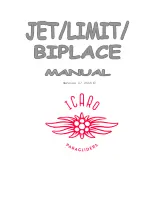
www.apcoaviation.com
15 LANDING
Before landing the pilot should determine the wind direction by checking a windsock,
flag, smoke drift or your drift over the ground while performing one or more 360
degree turns.
Always land into the wind.
At a height of about 50 meters above the ground begin your landing approach.
The most commonly used one is to head into the wind and depending on the wind
strength the pilot should reach his/her landing point by making s-turns.
At a height of about 15 meters make your final approach in trim speed into the
wind
At a height of 0.5 to 1.0 meter you can gently flare the glider by pulling gradually
down on the brakes to the stall point. When top-landing it is sometimes not
necessary to flare or a much gentler flare is necessary, especially in strong ridge
conditions.
15.1 TREE LANDING
If it is not possible to land in an open area, steer into the wind towards an
unobstructed tree and do a normal landing approach as if the tree is your landing
spot. Flare as you would for a normal landing. On impact keep your legs together and
protect your face with your arms.
After any tree landing it is very important to check all the lines, line measurements,
and the canopy for damage.
15.2 WATER LANDING
As you approach landing, release all harness buckles (and cross-bracing if present)
except for one leg. Just before landing, release the remaining buckle. It is advisable
to enter the water downwind. Let the canopy swing forward completely until it meets
the water with the leading edge openings; the air inside will be trapped forming a big
air mattress and giving the pilot more time to escape. Less water will enter the
canopy this way making the recovery much easier. Get away from the glider and
lines as soon as possible to avoid entanglement. Remember that a ballast bag can
be emptied and then inflated with air to aid flotation.
The canopy should be carefully inspected after a water landing, since it is very easy
to cause internal damage to the ribs if the canopy is lifted while containing water.
Always lift the canopy by the trailing edge, not by the lines or top or bottom
surface fabric.
15.3 LANDING IN TURBULENCE
One of the safest ways to land a glider in turbulent conditions is to use Big Ears. This
reduces the chances of getting a collapse during final approach. Use weight shift to
control your approach. It is possible to keep the ears in until you are ready to flare the
glider. Simply release the A-risers and flare the glider starting a little higher than
usual. Practice this in normal conditions before you need it in an emergency.
16 PACKING
Spread the canopy completely on the ground. Separate the lines to the left and the
right side of the glider. If the risers are removed from the harness, join the two risers
Page 18 of 24
Summary of Contents for Play 42 MK-II
Page 9: ...www apcoaviation com Page 9 of 24...
Page 20: ...www apcoaviation com 21 PLAY42 SKETCHES AND CERTIFICATION 21 1SKETCHES Page 20 of 24...
Page 21: ...www apcoaviation com Page 21 of 24...
Page 23: ...www apcoaviation com 22 PLAY42 MK II SKETCHES Page 23 of 24...
Page 24: ...www apcoaviation com APCO wishes you many hours of enjoyable flying Take Air Page 24 of 24...







































